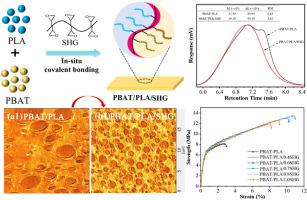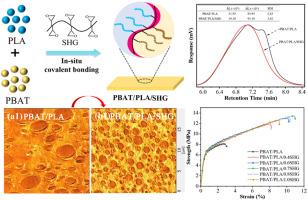生物可降解环氧基三元共聚物的合成,可同时提高聚己二酸丁二酯/聚乳酸共混物的机械性能和热性能
IF 4.5
2区 化学
Q2 POLYMER SCIENCE
引用次数: 0
摘要
聚乳酸(PLA)和聚己二酸丁烯-对苯二甲酸酯(PBAT)具有互补的物理化学性能,但PBAT/PLA共混物的界面相容性不理想,导致其力学性能较差。为解决相容性不足导致力学性能不理想的问题,设计并制备了一种可生物降解的环氧基三元共聚物,用于PBAT/PLA共混物的界面改性。以苯乙烯(St)、1,6-己二醇二丙烯酸酯(HDDA)和甲基丙烯酸缩水甘油酯(GMA)为自由基反应单体,在优化的聚合条件下,得到了转化率为70.3%、环氧化物值为0.351 mol/100g的St-HDDA-GMA三元共聚物(SHG)。以SHG为反应相容剂,采用熔融共混法制备了SHG填充的PBAT/PLA共混物。结果表明,SHG可以通过原位共价键有效改善PBAT/PLA共混物的界面相容性。与纯PBAT/PLA相比,掺入0.7 wt.% shg的PBAT/PLA共混材料的拉伸强度和断裂伸长率分别提高了48.2%和215.6%。流变性能和熔体流动指数测试表明,环氧基参与了PLA和PBAT的扩链反应,提高了共混物的界面结合力和界面缠结。此外,shg填充的PBAT/PLA共混物呈岛状结构,PLA相的球形颗粒尺寸较小,均匀分布在PBAT相内。本文章由计算机程序翻译,如有差异,请以英文原文为准。


Synthesis of a biodegradable epoxy-based terpolymer for simultaneously enhancing mechanical and thermal properties of poly(butylene adipate-co-terephthalate)/poly(lactic acid) blends
Poly(lactic acid) (PLA) and poly(butylene adipate-co-terephthalate) (PBAT) have complementary physical and chemical properties, but the interface compatibility of PBAT/PLA blends is not ideal, which leads to its poor mechanical properties. To solve the problem of unsatisfactory mechanical properties caused by insufficient compatibility, a biodegradable epoxy-based terpolymer was designed herein and prepared for the interface modification of PBAT/PLA blends. Using styrene (St), 1,6-hexanediol diacrylate (HDDA) and glycidyl methacrylate (GMA) as free radical reaction monomers, the St-HDDA-GMA terpolymer (SHG) with the conversion rate of 70.3 % and epoxide value of 0.351 mol/100g was obtained under optimizable polymerization conditions. SHG-filled PBAT/PLA blend was prepared by a melt blending method using SHG as the reactive compatibilizer. The results showed that SHG could effectively improve the interfacial compatibility of PBAT/PLA blends by in-situ covalent bonding. Compared with neat PBAT/PLA, the tensile strength and elongation at break of 0.7 wt% SHG-filled PBAT/PLA blend were enhanced by about 48.2 % and 215.6 %, respectively. The rheological properties and melt flow index tests showed that the epoxy group participated in the chain expanding reaction of PLA and PBAT, which improved the interface bonding force and interface entangling of the blend. Moreover, the SHG-filled PBAT/PLA blend presents an island-like structure, in which the spherical particles of the PLA phase are of small size and are uniformly distributed within the PBAT phase.
求助全文
通过发布文献求助,成功后即可免费获取论文全文。
去求助
来源期刊

Polymer
化学-高分子科学
CiteScore
7.90
自引率
8.70%
发文量
959
审稿时长
32 days
期刊介绍:
Polymer is an interdisciplinary journal dedicated to publishing innovative and significant advances in Polymer Physics, Chemistry and Technology. We welcome submissions on polymer hybrids, nanocomposites, characterisation and self-assembly. Polymer also publishes work on the technological application of polymers in energy and optoelectronics.
The main scope is covered but not limited to the following core areas:
Polymer Materials
Nanocomposites and hybrid nanomaterials
Polymer blends, films, fibres, networks and porous materials
Physical Characterization
Characterisation, modelling and simulation* of molecular and materials properties in bulk, solution, and thin films
Polymer Engineering
Advanced multiscale processing methods
Polymer Synthesis, Modification and Self-assembly
Including designer polymer architectures, mechanisms and kinetics, and supramolecular polymerization
Technological Applications
Polymers for energy generation and storage
Polymer membranes for separation technology
Polymers for opto- and microelectronics.
 求助内容:
求助内容: 应助结果提醒方式:
应助结果提醒方式:


